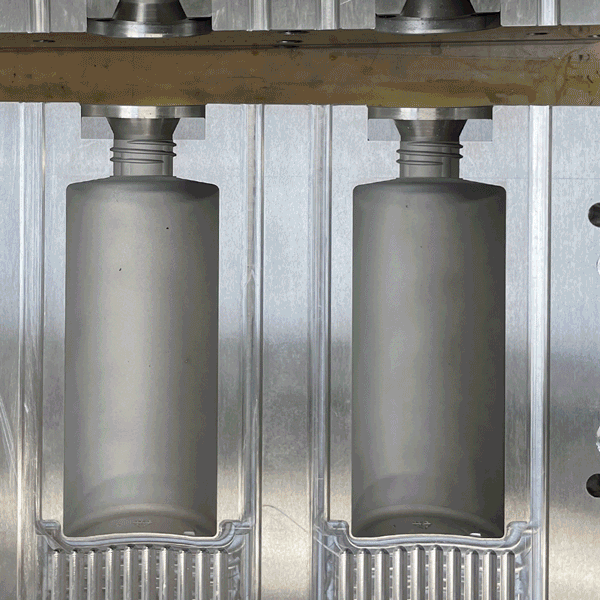technological innovation
17 September 2024
Technological innovations in the field of blown plastic containers are essential to improve production efficiency, reduce environmental impact and respond to growing market demands.
Here are some of the main innovations already adopted by Plastivalle.
1. Advanced blow-moulding technologies
Micro-injection blow moulding: This technique combines the process of micro-injection and blow moulding, allowing the production of containers with more complex and reinforced structures. This approach improves the strength of the final product without significantly increasing its weight. Multilayer (multilayer) blowing: Allows the creation of containers with multiple layers of different materials, allowing the use of specific barriers to improve container properties. Multilayer blowing also allows the use of recycling materials coupled with first generation plastics to produce bottles and jars intended for food and chemical substances.
2. Use of recycled materials and bioplastics
Recycled plastic: The integration of recycled plastic into production processes has become a priority, especially in response to environmental regulations and consumer demand for more sustainable products. Improvements in recycling processes result in high quality recycled materials suitable for blowing. Bioplastics: Research and development of bioplastics, derived from renewable sources, are advancing, allowing the production of containers that have a reduced environmental impact. Bioplastics are gaining popularity as an alternative to traditional petroleum-based plastics.
3. Optimization of process design and efficiency
Advanced simulation and modelling: The use of advanced simulation and modelling software allows you to optimize process parameters and container design before physical production, thus reducing waste and costs. Automated production technologies and Industry 4.0: The integration of robotics, artificial intelligence (AI) and IoT (Internet of Things) systems in the production of blown plastic containers allows for greater automation, Improving product efficiency and quality, as well as enabling predictive maintenance and real-time process monitoring.
4. Sustainability and reduction of environmental impact
Reduced container weight: Innovations in design and materials allow containers to be lighter without compromising their strength, thus reducing raw material use and CO2 emissions during production and transport. Reducing energy consumption: The adoption of more efficient technologies and optimised production processes contributes to the reduction of energy consumption, which is another crucial step towards sustainability.
5. Post-treatment and decoration technologies
Digital Decoration: Advanced digital printing technologies allow for the decoration of blown plastic containers with greater precision and customization, reducing waste and improving the aesthetics of the final product. Functional coatings: The application of specific coatings to containers can improve their resistance to scratches, adhesion of labels and other properties, contributing to a longer life and product quality.
These innovations respond not only to market demands in terms of quality and functionality, but also to a growing environmental awareness, promoting more sustainable production practices to which Plastivalle has long been oriented.
1. Advanced blow-moulding technologies
Micro-injection blow moulding: This technique combines the process of micro-injection and blow moulding, allowing the production of containers with more complex and reinforced structures. This approach improves the strength of the final product without significantly increasing its weight. Multilayer (multilayer) blowing: Allows the creation of containers with multiple layers of different materials, allowing the use of specific barriers to improve container properties. Multilayer blowing also allows the use of recycling materials coupled with first generation plastics to produce bottles and jars intended for food and chemical substances.
2. Use of recycled materials and bioplastics
Recycled plastic: The integration of recycled plastic into production processes has become a priority, especially in response to environmental regulations and consumer demand for more sustainable products. Improvements in recycling processes result in high quality recycled materials suitable for blowing. Bioplastics: Research and development of bioplastics, derived from renewable sources, are advancing, allowing the production of containers that have a reduced environmental impact. Bioplastics are gaining popularity as an alternative to traditional petroleum-based plastics.
3. Optimization of process design and efficiency
Advanced simulation and modelling: The use of advanced simulation and modelling software allows you to optimize process parameters and container design before physical production, thus reducing waste and costs. Automated production technologies and Industry 4.0: The integration of robotics, artificial intelligence (AI) and IoT (Internet of Things) systems in the production of blown plastic containers allows for greater automation, Improving product efficiency and quality, as well as enabling predictive maintenance and real-time process monitoring.
4. Sustainability and reduction of environmental impact
Reduced container weight: Innovations in design and materials allow containers to be lighter without compromising their strength, thus reducing raw material use and CO2 emissions during production and transport. Reducing energy consumption: The adoption of more efficient technologies and optimised production processes contributes to the reduction of energy consumption, which is another crucial step towards sustainability.
5. Post-treatment and decoration technologies
Digital Decoration: Advanced digital printing technologies allow for the decoration of blown plastic containers with greater precision and customization, reducing waste and improving the aesthetics of the final product. Functional coatings: The application of specific coatings to containers can improve their resistance to scratches, adhesion of labels and other properties, contributing to a longer life and product quality.
These innovations respond not only to market demands in terms of quality and functionality, but also to a growing environmental awareness, promoting more sustainable production practices to which Plastivalle has long been oriented.
